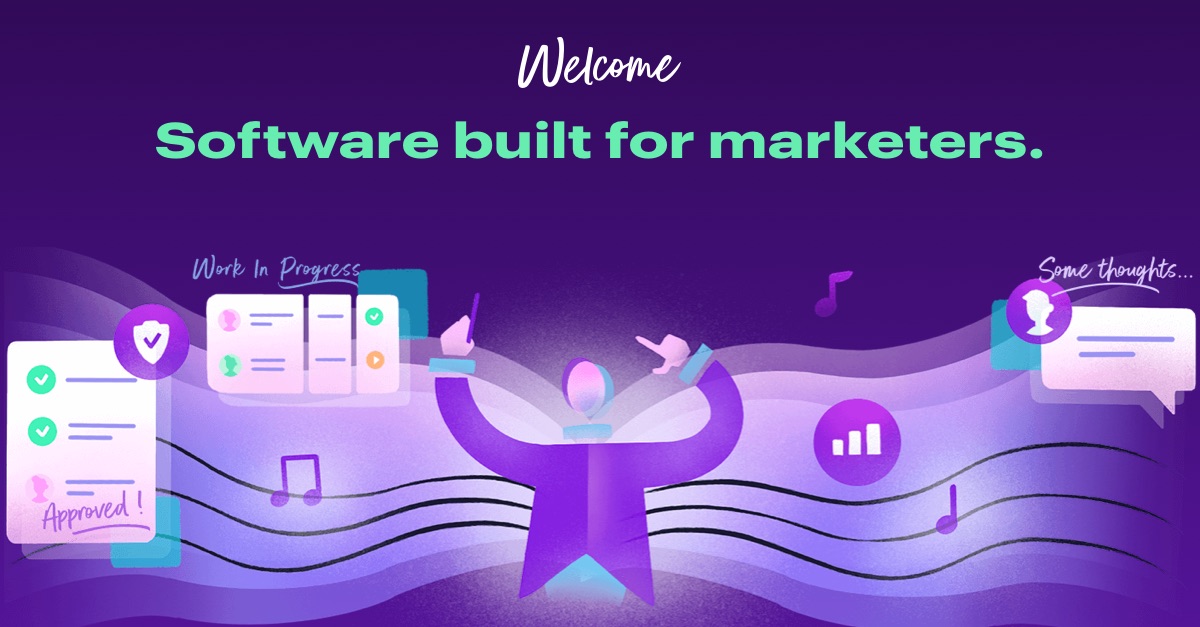MARKETING
5 Signs You’re Living in the DAM Stone Age

You’d laugh out loud if a colleague asked for a floppy disk with the latest creative files.
You might even chuckle if they requested a USB storage device.
But what if they asked for a link to the Google Drive or Dropbox folder?
Those living in the DAM Stone Age might not skip a beat, but enlightened marketers (who know a better way) would likely shake their heads in disappointment.
Digital asset management (DAM) is an evolving solution to help teams store, organize, and share content (images, PDFs, illustrations, articles, video files, and audio clips) in a single centralized location.
Basic solutions (like Google or Dropbox) let you stow content in folders and share it via links, but that’s just a tiny step up from storing your work in a file cabinet and giving your teammate the key. However, that’s how most organizations currently store their digital assets.
DAM platforms are a game-changer for businesses, but close to half of organizations haven’t tapped into the full power of DAM yet despite 55% of digital asset managers citing “organizing digital assets” as a top challenge.
Let us help.
Below, we’ll break down 5 different signs you’re living in the DAM Stone Age. If you recognize any of these issues (even a single one), there’s a good chance you need to ditch your current storage solution and upgrade to a modern-day integrated DAM platform.
Signs You Needed DAM Yesterday
1. The question “Can you send me the latest X?” gives you nightmares.
Stopping your work to find and share a file kills productivity. The American Psychological Association says that even a brief mental distraction (caused by shifting between tasks) can waste up to 40% of someone’s creative time.
Imagine how much that’d cost if you attached a 40% value sign to your team’s work. And that doesn’t even take into account the time you’re spending scouring your folders for the right file.
Scattered storage locations, varied asset-sharing methods, inconsistent naming and saving conventions, and lack of advanced search functionality can all lead to this massive time suck. Fortunately, a DAM solution solves it pretty quickly.
DAM platforms provide you with a single source of truth with all the most up-to-date assets across teams, markets, and/or LOBs. Anyone with the right credentials can browse, download, and use what they need without distracting you or your team.
Plus, with the right system in place, it’ll be just as easy to find what they need as it is for you, empowering everyone involved to self-serve.
Pro-Tip
Choose a DAM with support for a wide variety of file types, and simple ‘drag-and-drop’ and ‘multi-selection’ tools that allow users to add and categorize up to 200 assets in bulk, simultaneously improving organization while saving time. Use Labels (e.g. file names, format type, and other descriptive categories) and nested Folders to group similar content and accelerate content discovery when searching and filtering across single or shared global/local instances.
2. You’d rather buy or produce new content than repurpose existing assets.
Have you ever opened a content repository to find tons of duplicate assets and seemingly illogical naming conventions? That’s what happens when your living organization system turns into an over-bloated archive.
Tracking down the right person to answer your questions or help you find an asset can sometimes take longer than creating a brand-new piece of content. If you’d rather spend hours buying or producing a new piece of content rather than chasing down an existing asset, your asset management system needs an upgrade.
A DAM solution has advanced search functions and centralized asset archives that make it quick and easy to find what you need—saving you time and money.
Pro-Tip
Choose a DAM powered by AI & OCR (Optical Character Recognition) search. Machine-learning algorithms automatically apply tags to uploaded images, making it easy to filter, discover and ultimately reuse assets within the Library. Cutting-edge DAM platforms even enable duplicate asset recognition, an AI-powered feature that scans your assets to discover if any duplicates exist (and this goes beyond just the file name).

3. Your current DAM solution is totally isolated from your other MarTech systems.
You have enough usernames and passwords to manage already, right?
Even LastPass can’t prevent you from having to use multiple logins to access your assets, content management system (CMS), and creative software.
Archaic digital storage systems don’t play well with other applications. There are little-to-no integrations, and if an integration does exist, it’s far from out-of-the-box. This leads to many disconnected systems and time-wasting (and mistake-ridden) copy/paste processes.
Integrated DAM systems do much more than organize your assets—they empower you to use your assets without leaving the application. Whether you’re adding an illustration to a blog post, changing a logo on your website, publishing a video to YouTube, or adding a hero image to your email, a DAM solution lets you do it all from a single tab—not 17.
You want a DAM platform that’ll integrate with all your favorite applications, like Adobe Creative Cloud, WordPress, Highspot, Office 365, Marketo, Salesforce, and more. If it doesn’t, you’ll be back to creating complicated IFTTT (If This Then That) recipes to piece together your puzzle of applications.
Pro-Tip
Choose a DAM that enables bi-directional synchronization of assets and metadata with other systems of your choice. This is made possible by pre-built connectors that allow you to access DAM assets in real-time within tools that you use daily. Maximize utilization and improve productivity by downloading, editing, or initiating a new task/workflow directly from the Library.

4. You are never entirely sure who has access to your assets.
Digital security has never been more important. If you don’t know who can (and can’t) access your assets, security will always be compromised.
Some assets aren’t ready for the public’s eyes and others require signed NDAs for viewing. Any publicly-traded company knows the sensitivity of digital assets. The right document in the wrong hands (even accidentally) can lead to illegal insider trading—and that’s just the beginning of civil and criminal fines and charges.
On a more toned-down note (although still important), imagine your content team accessing and using a new brand design that hasn’t been reviewed and approved yet. Access to digital assets should be limited and controlled for the sake of all involved.
DAM systems’ governance lets you define user permissions and rights, ensuring the wrong people don’t stumble upon assets. These platforms also perform regular security checks and data backups. You can even see who viewed and downloaded an asset, when they accessed it, and how they used it—ensuring assets get used timely and appropriately.
Pro-Tip
Choose a DAM that enables you to monitor the use of content across all teams, lines of business, and markets. By tracking the lineage and history of marketing assets, you can see a clear picture of who is repurposing what content and when. Additionally, look for functionality to designate an expiration date for individual assets using a simple “date picker”. Consequently, you can filter for assets that are about to expire and/or receive email and in-app notifications so you can take the appropriate action.

5. You struggle with brand consistency.
Do you have multiple logos from the past few years floating around the digital world? Have you seen inconsistent product descriptions or taglines used across your website?
Sounds like you have a problem with brand consistency.
While these might sound like minor nuisances and easy fixes, they can take a real toll on your company’s brand reputation. However, getting everyone on the same page isn’t quite as simple as sending a @here Slack message or all-company email—getting 100% message consumption is nearly impossible.
Instead of communicating every brand change with your entire company, a DAM system lets you update your accessible brand assets (logos, fonts, colors, b-roll, etc.) in a centralized location, so everyone gets the update. Archive the old branding options and voilà—your teams should only have access to the most up-to-date assets now.
Because DAM platforms let you edit and publish straight from the application (see sign #3), you don’t have to worry about people downloading and using outdated assets onto their hard drives that could damage your brand reputation.
Pro-Tip
Choose a DAM that lets you upload and maintain multiple versions with history to see all previous iterations of an uploaded asset for cross-market sharing, translation, and localization. Curate a collection of assets to share and distribute (internally or externally) through a public link, and/or embed your Collection as an iFrame in the places your stakeholders need to access content (e.g. SFDC, partner portal, intranet, etc.).

Conclusion
Do you recognize any of the signs resonating with your or your company? Don’t worry—you’re not alone. While DAM isn’t necessarily a new tool, it still lacks global adoption.
Fortunately, replacing your primitive storage systems with a DAM solution isn’t as daunting as it sounds—and the sooner you make the change, the easier the transition will be.
Give Welcome a try. We provide a state-of-the-art DAM system that’s comprehensive, flexible, and downright powerful. It also includes content marketing, project management, calendaring, creative services, performance analytics, and more.
![]()
Source link



















You must be logged in to post a comment Login